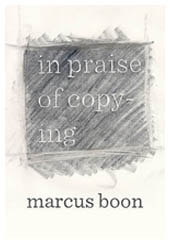In Praise of Copying | By Marcus Boon | Harvard University Press | 304 pages, $25.95
In the mythology section of a used bookstore I once frequented, there was a fat hardcover called The Golden Bough, by a certain Sir James George Frazer, which sat in a perpetually untouched and dusty splendor. At the time, it seemed either very interesting (and underappreciated) or very boring, because it never budged from its spot on the top shelf. Would that I had been a more curious browser: The Golden Bough is in fact an influential treatise on religion, mimesis, magic, and many other things. It’s also one of the many unexpected sources that Marcus Boon draws upon in his insightful new study, In Praise of Copying.
 Boon, an associate professor of English at York University in Toronto, asks us to reconsider our very understanding of the act of copying. His book, he notes, “grew out of the observation that copying is pervasive in contemporary culture, yet at the same time subject to laws, restrictions, and attitudes that suggest that it is wrong, and shouldn’t be happening.” We tend to see copying as a form of theft, Boon argues, an act of infringement that leaves the original work (and possibly its creator) bereft.
Boon, an associate professor of English at York University in Toronto, asks us to reconsider our very understanding of the act of copying. His book, he notes, “grew out of the observation that copying is pervasive in contemporary culture, yet at the same time subject to laws, restrictions, and attitudes that suggest that it is wrong, and shouldn’t be happening.” We tend to see copying as a form of theft, Boon argues, an act of infringement that leaves the original work (and possibly its creator) bereft.
In a fascinating etymological journey, Boon turns to an earlier iteration of the word “copy”—the Latin word “copia,” with the “meanings of abundance, multiplicity… still contained in the word ‘copious’ today.” It wasn’t until the end of the sixteenth century, he writes, that the more contemporary definition of the word—i.e., something made in imitation of something else—gained traction. At that point, too, it acquired its pejorative flavor, suggesting “a degraded version of an original.”
To show the vast reach of copia, Boon takes on many forms of modeling and mimesis. He looks, for instance, at the classical, repetitive elements of formal rhetoric; the contagion of violence; the human fascination with the magic of multiplication (cue The Golden Bough!); and, not least of all, the endless varieties of appropriation, fracture, and transformation taken up by folk and subaltern cultures.
Be forewarned: In Praise of Copying is neither a practical book nor a policy statement. While Boon touches on current issues in intellectual property law, he sidesteps any sustained discussion of the topic. What he does give us is a rich and contextual history of copying—with philosophical, etymological, and even biological threads—beginning with the legacy of the Platonic copy. Here, argues the author, is the somewhat rigid and limited basis for today’s IP laws: you cannot protect an idea, but you can protect a fixed and material expression of that idea.
For sure, Boon is opposed to the legal strictures and social taboos that surround copying today. Take the following passage, whose rune-reading eloquence recalls the post horn symbols in The Crying of Lot 49: “The word ‘copy’ appears today at all those locations where the dominant capitalist economic structure stutters and stumbles. Copying and the crises that surround it today are… the manifestation of traces of some other economy, future, present, or past…. Thus, they appear as the markers of the danger of an excess or abundance that needs to be controlled.” Still, there’s clearly a chasm between Boon’s meditative parsing and today’s plethora of IP-related issues.
What bridges this chasm, at least to some extent, is the book’s open and generous sensibility. Boon is determined to be inclusive and explanatory, rather than exclusive and accusatory. He also has a personal interest in Buddhism, and this perspective informs his writing, lending alternative interpretations of copia formed by non-Western philosophies and traditions. In his introduction, he draws a comparison between theme parks and Tibetan monasteries, noting that “just as a Disney theme park is an iteration of a framework, albeit one with a not particularly stellar meaning, the Tibetan monasteries are also ‘hard copies’ of a mental framework.” As different as they are, Space Mountain and Mount Meru are both emblematic to Boon of the mimetic frameworks that exist all around, whether we acknowledge them or not. “What if copying,” he asks, “rather than being an aberration or a mistake or a crime, is a fundamental condition or requirement for anything, human or not, to exist at all?”
Those that find resonance in the above question (or this one: “If it looks like a Louis Vuitton bag, is it a Louis Vuitton bag?”) will probably relish In Praise of Copying. Readers with interest in topics like epistemology or translation will likewise encounter plenty of tasty tidbits for the nibbling. The book won’t float everyone’s boat. As someone who enjoys theory but hasn’t read Baudrillard in a while, I did find parts of it rather self-referential. Overall, though, Boon has found a compelling way to explore and contextualize an often tetchy topic.
Click here for a complete Page Views archive.
Jane Kim is a writer in New York.
